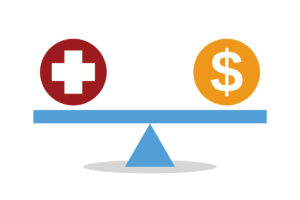Editor’s Note: This perspective was originally published on Health Affairs Forefront on June 10, 2024.
A recent Health Affairs Forefront article titled House QALY Ban Could Harm, Not Help, People with Disabilities and Chronic Illness, expresses disappointment over the House bill, Protecting Health Care for All Patients Act (HR 485) that was passed on February 7, 2024, by the US House of Representatives. This bill amends “the Social Security Act to prohibit the use of quality-adjusted life years and similar measures in coverage and payment determinations under Federal health care programs.” We are sympathetic to the distinguished authors—Professors Robert Kaplan, Peter Neumann, Joshua Salomon, and Marthe Gold—who call for the use of data on preferences and the tools of economics to prioritize health care programs to maximize health benefits to all Americans. At the same time, since economics is meant to describe preferences, not prescribe them, we must take seriously the vehement opposition to quality-adjusted life-years (QALYs) and find a way to reconcile it with economic approaches.
Both the Affordable Care Act and the Inflation Reduction Act (IRA) provide prima facie evidence of distaste for value assessment methods that discriminate against sicker groups. QALYs discriminate in the sense that an extra year of life is worth less when it accrues to a sicker group. This property follows from two important assumptions of the QALY model: Sicker groups gain fewer QALYs from a fixed increase in life expectancy; and an additional QALY is worth the same to sicker and healthier groups. Many authors have proposed discarding the first assumption as a means of eliminating discrimination. For instance, some researchers have proposed simply measuring life-years gained, without attempting to account for health-related quality of life. If our goal is to describe human preferences, discarding this assumption is the wrong approach because it ignores the self-evident fact that people prefer to live in good health rather than poor health. Ironically, the proposed “fixes” to QALYs can themselves discriminate against persons who are disabled when there is a shift in the standard of care, causing the very problem they try to resolve.
The second assumption, however, is problematic. First, it is now well-established that to achieve a small gain in health-related quality of life, sicker patients are willing to pay more for health care than healthy patients. QALYs fail to account for this; incremental gain in health is worth the same to a sick person as to a healthy person under the QALY model. Not only does this inadequately represent preferences, it also discounts the value of health improvements to the sickest persons in society.
Moreover, the assumption of equal value for QALYs implies that consumers are indifferent to risk, but the empirical evidence suggests otherwise. We have found that when people are very sick, they are risk-seeking and thus favor treatments that are “long-shots.” However, when people are healthy, they are risk-averse and favor treatments that are “safe-bets.” This finding occurs among both cancer patients and also among a representative US population sample contemplating hypothetical health choices. In the real world, it is widely known that people with cancer often seek new or experimental treatments whereas healthy people avoid them. Such behavior is not irrational if sicker patients value small improvements to health more than healthy people. QALYs fail to account for this empirical finding, and this can lead to perverse QALY-based recommendations such as prescriptions of Viagra for erectile dysfunction being more cost-effective than kidney transplants. This and other unacceptable results have led to ad-hoc approaches to address equity, with the vast majority reporting greater value after equity adjustments.
These concerns now loom larger in the US policy context because economic evaluation may well be used to set prices for prescription drugs under the IRA. This prospect introduces the risk that QALYs will “devalue groups of people, such as individuals with cancer or those with disabilities” because the lower value placed on life extension for these groups leads to lower value-based prices and weaker incentives to innovate in the service of vulnerable patients. In this respect, the continued reliance on QALYs as a measure may well threaten long-term health equity.
Nonetheless, we completely agree with an essential point made by Professors Kaplan, Neumann, Salomon, and Gold: the critical need for rigorous economic approaches to allocate health care rationally. What is the solution? We have shown that greater equity in health care is possible when a Generalized Risk-Adjusted Cost-Effectiveness (GRACE) model is used. This model extends QALYs to capture the varying risk posture of sick and well individuals to better align stated preferences with revealed preferences expressed by patients, policy makers, and US citizens. GRACE recognizes the possibility that sicker patients place greater value on a given health improvement. Known in economics as the principle of “diminishing returns,” this explains, for instance, why $100 paid to improve the circumstances of a family in extreme poverty is more valuable than $100 paid to a wealthy family. Applied to health, this principle implies that people with chronic illness or disability place more value on health improvements. This contrasts with standard cost-effectiveness analysis, which implies that people with a disability derive no more and often less value from health gains. By recognizing the importance of diminishing returns, GRACE mitigates discrimination against disabled persons. Most importantly, when empirically realistic preferences for health are used, GRACE eliminates disability discrimination entirely (Theorem 6).
The GRACE model offers a more equitable approach to health care evaluation, ensuring that the diverse needs and preferences of all individuals are considered. By adopting such a model, we can move toward a health care system that better prioritizes the well-being of all its constituents.
Authors’ Note
Jason Doctor is principal investigator on a dissertation fellowship funded by Edwards Life Sciences Foundation. In the past three years, Darius Lakdawalla has received speaker fees, travel assistance, or consulting income from the following sources: Amgen, Genentech, Gilead, GRAIL, Mylan, Novartis, Otsuka, Perrigo, Pfizer, and Sorrento Therapeutics. Dr. Lakdawalla also owns equity in Precision Medicine Group, for which he previously served as a consultant. He is also co-founder and chief scientific officer of EntityRisk, Inc., which develops software and analytic tools for use by health care firms.
“How To Advance The Debate Over QALYs: A Response To Kaplan et al.”, Health Affairs Forefront, June 10, 2024.DOI: 10.1377/forefront.20240607.883603
Copyright © [2024] Health Affairs by Project HOPE – The People-to-People Health Foundation, Inc.
Sign up for Schaeffer Center news
Related Work
-
Journal Articles
A Principled Approach to Non‑Discrimination in Cost‑Effectiveness




